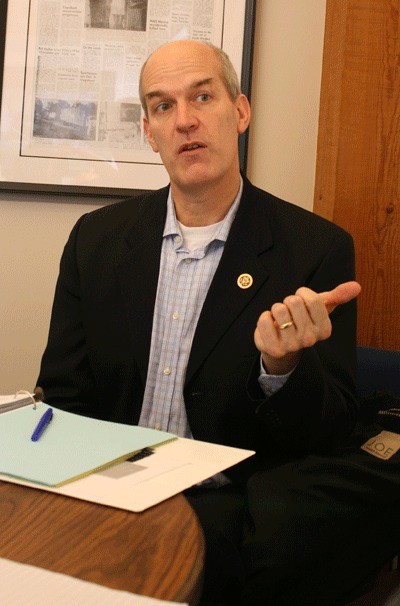Now that Congress has finally passed a budget, federal legislators can now get down to business, Congressman Rick Larsen said this week.
Larsen outlined the next steps for Congress in the coming year and answered questions about local issues during a sit-down Thursday with the Whidbey News-Times.
“The big picture that we’re dealing with in Congress is that the budget deal that we came to in December mostly put a halt now to the ‘shut the government down, keep it open, shut the government down, keep it open’ routine we’ve gotten into,” Larsen said.
“And that’s good news and lets us go forward with the spending bills.”
Once President Barack Obama releases his budget in May, legislators will start writing the 2015 appropriation bills that include spending for veterans, defense, transportation and other key government functions.
“It may not mean it will increase the approval ratings, it will certainly let us get on with doing our job,” Larsen said.
He predicts that, during his State of the Union address next week, the president will highlight one of Larsen’s key ojectives — raising the minimum wage.
“The demographic of the low-wage worker has changed demonstrably in the last 30 years,” Larsen said. He said the average low-wage worker’s age is now 35 and that 56 percent of low-wage workers are women.
“The myth of the teenager being the predominant group isn’t true anymore,” Larsen said.
Larsen is co-sponsor of a bill to raise the federal minimum wage to $10.10 an hour over a three-year period. He said that 62 House and Senate Republicans voted for the last wage increase under President George W. Bush “so there is the possibility for broad support for this.”
“It’s an important point that the minimum wage has the purchase power of the 1968 minimum wage,” Larsen said.
Larsen also said the United States must invest in transportation infrastructure and education to create jobs and grow the economy in the long run.
Congress is working on a five-year transportation plan that should include improvements to Washington state ferry terminals, he said.
The transportation bill will be an important part of job creation, he said, adding Congress passed the SAFE Bridges Act last year, in response in part to the Skagit Valley River bridge collapse. He said that will be rolled into the transportation bill.
This will, Larsen said, “put people to work maintaining and repairing the bridges of this country.”
As for the future of Whidbey Island Naval Air Station, Larsen said, “things are in a good place” for the base, which is expecting three or four additional P8-A squadrons and potentially two more EA-18G Growler squadrons.
“It’s all good news for the north end (of Whidbey),” Larsen said.
The fact that NAS Whidbey is the sole location for the Navy’s Growlers has raised concerns from those living near the airfields where touch-and-go training is conducted. Some claim the Growler noise is damaging the health of residents and are demanding that Outlying Field Coupeville, or OLF, be closed and the Growlers based elsewhere.
Asked if he believes the Growler squadrons now using OLF might be moved to another location, Larsen responded, “Where is that?”
“That’s the point. There isn’t (another location).”
“I think that’s a better question for the Navy, but I think the Navy would say that’s the issue,” Larsen said. “You just don’t pick up the planes and put them down, you have to pick up the people and put them down, pick up the buildings and put them down.”
“It’s not just a matter of just moving airplanes.”
Larsen said the federal defense budget is lower than projected as a result of sequestration and that the Navy is not looking to develop new locations. Getting the Navy to move OLF is unlikely, he said.
“I don’t know, I just don’t see that that’s in the cards,” Larsen said. “I know there’s a desire from some people on the island to do that, I don’t see that that’s in the cards. The military generally isn’t looking to spend money developing new places because they’re not getting a lot of new money from Congress.”
“They’re not going to be doing things that add to training costs or add to operation costs.”
Asked whether is inevitable that the Navy’s technology will outgrow OLF, Larsen deferred to the ongoing Environmental Impact Statement that started in July.
“I don’t know the answer to that — that’s why they’re doing an EIS,” Larsen said. “They have plenty of physical space but it’s a matter of whether the training space is available to them.”
When asked if he believes he is being responsive to the concerns of those concerned about jet noise at OLF Coupeville, Larsen listed 24 instances this past year in which he met with or corresponded with local leaders, those calling for the closure OLF Coupeville and other residents.
“What I sometimes find is when I hear from folks that I’m not listening to them, they’re saying I don’t agree with them, that sometimes does occur,” Larsen said.
He stressed that even though he may not be able to attend every meeting personally, “it doesn’t mean I don’t hear what people are saying.”



